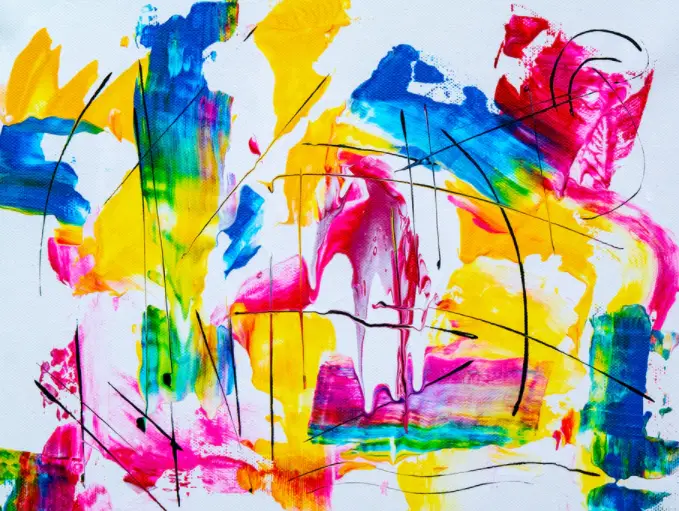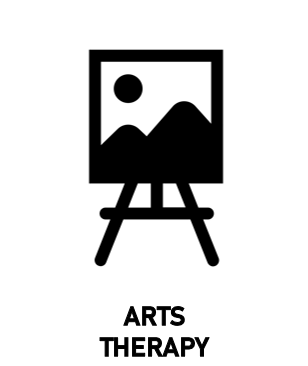Arts and creative therapy (also known as expressive arts therapy, creative arts therapy, expressive therapies etc) can help people find a way to express their thoughts and feelings in an easier way.
This type of therapy involves an individual creating art, an object or piece of music, which can normally be used by a therapist to link to certain problems.
Arts therapy can be a good alternative to talking therapy if needed – especially for those that struggle to communicate in more normal ways.

The Science Behind Arts Therapy
Arts Therapy is normally used by individual’s that are unable to express their thoughts in more conventional talking therapies.
They may struggle to coherently explain their thoughts and feelings, and instead may prefer using arts as an outlet for their problems.
In general, arts therapy involves any creation of art, dance/movement, music, poetry or drama, with each individual case typically differing..
The assumption generally is that the mind, body and spirit are all interconnected. Different forms exist, but by getting an individual to express themselves in a medium that they are passionate about makes it easier to attain therapeutic goals.
How Does Arts Therapy Work?
Arts therapy is carried out by trained therapists. They aim to help patients express themselves using art. Sessions can be both in a group setting, or on a one-on-one basis.
A patient will present their problems to the therapist, and over time, the patient will be taught techniques which can help them with their problems.
A patient may find that having an outlet for their feelings is very useful. The techniques used depend on which form of arts therapy is used. We have an article that looks at the key differences here.
An example would be in art, a patient may be asked by their therapist to freely create a drawing that depicts their feelings, thoughts or any past experience.
It can help a therapist see the ways a person is thinking, thus helping him/her to understand their troubles, and subsequently help treat areas that are causing problems.
Arts therapy can be conducted in many different ways, and each session will be tailored to a patient’s problems or thoughts.
Commitment to Arts therapy is important, as it will help an individual get the most from the sessions, and maximise their chances of recovery.
Most people finish Arts therapy with an improvement in their mental health. There is no set timeline for Arts therapy to be finished, it will be contingent on the progress of the patient.
They may go on and undertake a more intensive form of talking therapy, or may instead return to their normal life. Long-term coping mechanisms taught in Arts therapy can help protect against relapse.
When is Arts Therapy Useful?
Arts Therapy can be useful in any case where an individual struggles to express their thoughts, feelings or anything else, verbally.
They may find art is an easier way to express themselves, and therefore gain more benefit from this form of therapy, rather than regular talking therapies.
Patients with Borderline Personality Disorder, Schizophrenia, Schizoaffective Disorder, Somatic Disorders and some cases of Anxiety, will often find Arts therapy useful.
Away from mental health, those with Autism Spectrum Disorder can also derive benefit from Arts therapy.
How effective is Arts Therapy?
Evidence is mixed when it comes to the effectiveness of Arts therapy, and it has proven to be a controversial subject.
Arts therapy is often lauded as a potential treatment for Schizophrenia, though multiple studies suggest it is of limited use in many cases [1][2].
However, evidence for use of arts therapy in the treatment of Borderline Personality Disorder is more positive. One small study found that its participants saw improvements in multiple areas associated with BPD, such as less self-injury and more emotional regulation after partaking in Arts Therapy [3].
There is some evidence for the use of arts therapy as a short-term measure for depression, though this evidence is flimsy at best [4]. Some studies do exist which suggest that Arts therapy can be beneficial for mental health [5].
Despite the evidence, many people will find Arts therapy provides significant help to them. But with everyone being unique, it is difficult to tell if arts therapy will or won’t work for everyone.
How to find a therapist?
It is recommended that you contact your GP and inform them of your problems. They will refer you to the relevant mental health team.
If you are aiming to use the private sector, you could ask your GP or someone you know for a recommendation. You can also look online – the British Association for Counselling and Psychotherapy have a therapist directory on their site.
See Also
- Therapy Home
- Everything You Need To Know About Talking Therapy
- FAQ’s About Talking Therapy
- Arts Therapy: Everything You Need to Know
- The Advantages and Disadvantages of Arts Therapy
- 8 Things You Should Know About Arts Therapy
- What Are The Different Types of Arts Therapy?
Disclaimer
This website should be used purely for informational purposes, and does not intend to, nor should it ever, be used as a replacement for professional medical advice.
We strive to keep all of our pages updated, and ensure that our website is full of factual and in-depth information. However, we encourage you to browse this website with care.
As a reminder, this website and all content within it cannot and should not replace the advice of a trained medical professional. You can read our full disclaimer at this link.
Helplines
If you are struggling with your mental health, help is available. With the right support and treatment, you can make a recovery. For information on helplines, or if you are in a state of crisis, please visit our crisis page by clicking on the relevant link for your geographical location (United Kingdom), (United States), (International). You can also see how to get mental health treatment and the process involved by clicking this link.
References
[1] Priebe, S., Savill, M., Wykes, T., Bentall, R., Reininghaus, U., Lauber, C., Bremner, S., Eldridge, S., & Rohricht, F. (2016). Effectiveness of group body psychotherapy for negative symptoms of schizophrenia: Multicentre randomised controlled trial. The British Journal of Psychiatry. 209 (1), p54-61.
[2] Ruddy, R. & Milnes, D. (2005). Art therapy for schizophrenia or schizophrenia-like illnesses. Cochrane Database of Systematic Reviews. (Issue 1).
[3] Martin, S., Martin, G., Lequertier, B., Swannell, S., Follent, A., & Choe, F. (2012). Voice Movement Therapy: Evaluation of a Group-Based Expressive Arts Therapy for Nonsuicidal Self-Injury in Young Adults. Music and Medicine. 5 (1), p31-38.
[4] Thyme, K. E., Sundin, E. C., Stahlberg, G., Lindstrom, B., Eklof, H., & Wiberg, B. (2007). The outcome of short-term psychodynamic art therapy compared to short -term psychodynamic verbal therapy for depressed women. Psychoanalytic Psychotherapy, 21(3), p250-264.
[5] Kiepe, M-S., Stöckigt, B., & Keil, T. (2012). Effects of dance therapy and ballroom dances on physical and mental illnesses: A systematic review. The Arts in Psychotherapy, 39(5), p404–411.

































